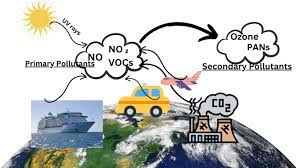The Gothenburg Protocol is an international agreement established under the United Nations Economic Commission for Europe (UNECE) to address trans boundary air pollution and its adverse effects on human health and the environment. Named after the city of Gothenburg, Sweden, where negotiations for the protocol took place, it was adopted in 1999 and later amended in 2012. The primary goal of the Gothenburg Protocol is to control and reduce emissions of key air pollutants that can cross national borders and affect neighboring countries.

Table of Contents
Key Elements of the Gothenburg Protocol
- Emission Reduction Targets: The protocol sets legally binding emission reduction targets for several major air pollutants, including sulfur dioxide (SO2), nitrogen oxides (NOx), volatile organic compounds (VOCs), ammonia (NH3), and fine particulate matter (PM2.5). These targets aim to reduce the levels of these pollutants in the atmosphere and mitigate their adverse impacts.
- National Emission Ceilings (NECs): Participating countries establish national emission ceilings for each of the specified pollutants. These ceilings represent the maximum allowable emissions from various sources within a country. The goal is to ensure that emissions stay below these ceilings to prevent transboundary pollution and its associated effects.
- Flexibility Mechanisms: The Gothenburg Protocol includes market-based mechanisms that allow countries to trade emission reduction credits among themselves. This flexibility enables countries to achieve their emission reduction targets in a cost-effective and efficient manner.
- Review and Revision: The protocol includes provisions for periodic review and revision of the emission reduction targets and national emission ceilings. These reviews take into account scientific knowledge, technological advancements, and the overall progress made toward reducing air pollution.
- Transboundary Effects: The protocol recognizes that air pollution can travel across national borders, affecting the air quality and environment of neighboring countries. It emphasizes the need for international cooperation and coordinated efforts to address transboundary air pollution.
- Effects on Human Health and Environment: The Gothenburg Protocol places a strong emphasis on protecting human health and the environment from the harmful effects of air pollution. By reducing emissions of pollutants that contribute to smog, acid rain, and particulate matter, the protocol aims to improve air quality and reduce related health and environmental risks.
Achievements and Impacts
Since its adoption, the Gothenburg Protocol has played a significant role in improving air quality and reducing emissions of transboundary air pollutants in Europe. It has contributed to the reduction of acid rain, lowered ground-level ozone concentrations, and improved respiratory health outcomes for populations in the region.
By promoting international cooperation, setting emission reduction targets, and providing mechanisms for flexibility and review, the Gothenburg Protocol serves as a model for addressing cross-border air pollution challenges. It underscores the importance of global and regional collaboration in addressing environmental issues that transcend national boundaries and highlights the positive outcomes that can be achieved through coordinated efforts to reduce air pollution.
Read: